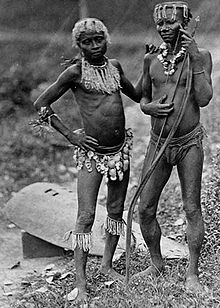大アンダマン人
大アンダマン人(Great Andamanese)は、アンダマン諸島にある大アンダマン諸島の先住民(アンダマン人)(ネグリト)である。諸島内にいくつかの部族に分かれて住んでいた。母語は大アンダマン語族[3]。同じくアンダマン諸島の原住民であるオンガン人とは言語系統が異なる。かつては2000~6600人ほどが暮らしていたと推定されているが、病気、アルコール、植民地戦争、狩猟採集エリアの消失などにより、激減し、2010年には52人が残るのみとなった[1][4]。
 | |
| 総人口 | |
|---|---|
| 52人 (2010)[1] | |
| 居住地域 | |
アンダマン・ニコバル諸島 | 52 |
| 言語 | |
| 元来は大アンダマン語族, 今日は主にヒンディー語や他のインドの言語 | |
| 宗教 | |
| ヒンドゥー教[2] | |
部族と人口
編集- 北部群 (Yerewa):
- (Aka-)Kari or Cari – 北アンダマン島北部 – 2人(1994年)[5]
- (Aka-)Kora, Khora or Cora – 北アンダマン島東部 – 1994年に絶滅[5]
- (Aka-)Bo – 北アンダマン島西部 – 15人(1994年)[5]
- (Aka-)Jeru – 北アンダマン島南部 – 19人(1994年)[5]
- 南部群 (Bojigyab):
- (Aka-)Kede – 中アンダマン島北部 – 1931年直後に絶滅[6]
- (Aka-)Kol – 中アンダマン島南東部 – 1921年までに絶滅[6]
- (Oko-)Juwoi – 中アンダマン島南西部 – 1931年までに絶滅[6]
- (A-)Pucikwar – 南アンダマン島北東部およびBaratang島 – 1931年直後に絶滅[6]
- (Akar-)Bale – Ritchie's島 – 1931年直後に絶滅[6]
- (Aka-)Bea – 南アンダマン島沿岸部およびRutland島 – 1931年までに絶滅[6]
その他、1994年時点で部族に帰属しない人口が4人[7]。
遺伝子
編集大アンダマン人は出アフリカ後「南ルート」[8]をとったハプログループF*、K*、L、P*、および「北ルート」のオーストロアジア系O1b1が合計100%である。(これはオンガン人(ジャラワ族、オンゲ族)がハプログループD1a2bのみが100%を占める[9][10]のとは大きく異なる。)
ミトコンドリアDNAハプログループは、出アフリカ後「南ルート」で到達したM31、M32のみが観察される[9][11]。
脚注
編集- ^ a b "Language lost as last member of Andaman tribe dies" (5 February 2010). The Daily Telegraph, London. Accessed 3 January 2017.
- ^ ST-14, Census of India 2001
- ^ Jarawa: The Great Andamanese – Survival International, "The Great Andamanese were originally ten distinct tribes, including the Jeru, Bea, Bo, Khora and Pucikwar. Each had its own distinct language, and numbered between about 200 and 700 people. They are now collectively known as the Great Andamanese."
- ^ (2011) "Lives Remembered". The Daily Telegraph, London, 10 February 2010. Accessed on 2010-02-22. Also [https://web.archive.org/web/20100213125406/http://www.telegraph.co.uk/news/obituaries/7207731/Lives-Remembered.html on web.archive.org
- ^ a b c d A. N. Sharma (2003), Tribal Development in the Andaman Islands, page 75. Sarup & Sons, New Delhi.
- ^ a b c d e f George van Driem (2001), Languages of the Himalayas: An Ethnolinguistic Handbook of the Greater Himalayan Region : Containing an Introduction to the Symbiotic Theory of Language, BRILL, ISBN 90-04-12062-9, ... The Aka-Kol tribe of Middle Andaman became extinct by 1921. The Oko-Juwoi of Middle Andaman and the Aka-Bea of South Andaman and Rutland Island were extinct by 1931. The Akar-Bale of Ritchie's Archipelago, the Aka-Kede of Middle Andaman and the A-Pucikwar of South Andaman Island soon followed. By 1951, the census counted a total of only 23 Greater Andamanese and 10 Sentinelese. That means that just ten men, twelve women and one child remained of the Aka-Kora, Aka-Cari and Aka-Jeru tribes of Greater Andaman and only ten natives of North Sentinel Island ...
- ^ A. N. Sharma (2003), Tribal Development in the Andaman Islands, page 75. Sarup & Sons, New Delhi.
- ^ 崎谷満『DNA・考古・言語の学際研究が示す新・日本列島史』(勉誠出版 2009年)
- ^ a b Kumarasamy Thangaraj, Lalji Singh, Alla G. Reddy, V.Raghavendra Rao, Subhash C. Sehgal, Peter A. Underhill, Melanie Pierson, Ian G. Frame, Erika Hagelberg(2003);Genetic Affinities of the Andaman Islanders, a Vanishing Human Population ;Current Biology Volume 13, Issue 2, 21 January 2003, Pages 86–93 doi:10.1016/S0960-9822(02)01336-2
- ^ アンダマン諸島については、従来よりハプログループD-M174*(xD-M15,D-M55)が高頻度であるとのデータ(kumarasamy et al. 2003)があり、その後系統解析の研究の進展によりアンダマン諸島のD-M174*はD-Y34537であることがわかった(Y-Full)なお、Y-Fullでは、D-Y34537とD-M55が姉妹群を成すとしている。ただし両者の分岐年代は5万3000年以上前である(Mondal et al. 2017)。
- ^ Kumarasamy Thangaraj, Gyaneshwer Chaubey, Toomas Kivisild, Alla G. Reddy, Vijay Kumar Singh, Avinash A. Rasalkar, Lalji Singh1(2005);Reconstructing the Origin of Andaman Islanders ;Science13 May 2005: Vol. 308 no. 5724 p. 996 DOI: 10.1126/science.1109987